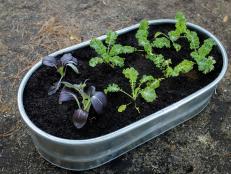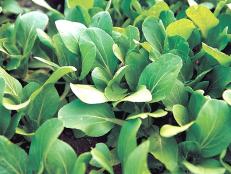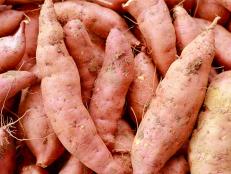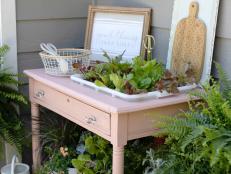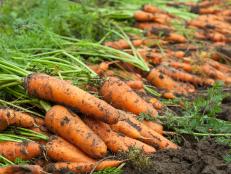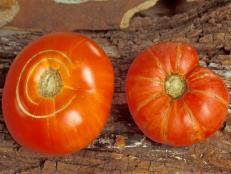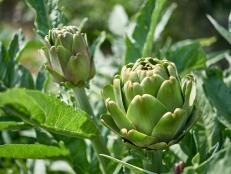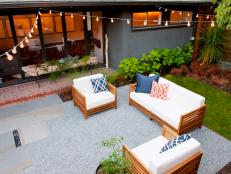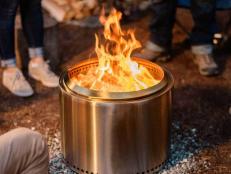Garden to Table: Mixed Lettuce
Lettuce is one of the best dressed vegetables at market.

Image courtesy of Sweetman's General Store
With so many gardeners looking for recipes to capitalize on their homegrown goodness, we thought this was the perfect time for a feature that combines growing and eating: Garden to Table, produced with our friends at the Food Network blog FN Dish. Farmer-bloggers Judith Winfrey and Joe Reynolds offer their tips for sowing, growing and harvesting. And then we kick it over to FN Dish for some delicious recipes using this seasonal produce.
Lettuce is one of those classic crops, whether you find it in your salad bowl or garden. The Egyptians were the first to domesticate wild lettuce varieties, but the Romans weren’t too far behind. In the Roman Empire multiple lettuce varieties were grown. The Romans referred to lettuce as “lactuca” to describe the milky substance that comes from the stem of the plant when it is cut. That history jumps a millennia forward to find lettuce as one of the most widely grown vegetable crops in the world.
Related to sunflowers, Jerusalem artichokes, chicories, and many ornamental flower varieties, lettuce presents itself in a great diversity of forms and colors. For our planning on the farm, we strive to grow roughly ten varieties for cutting lettuce, about four of which double as varieties that have the ability to grow large, full heads. Loaded with vitamin A and potassium, lettuce does not like it too hot or too cold. We often find in our hot Southern growing season that we have better success cutting heads as a spring crop and harvesting lettuce loose to be mixed with other tender greens, such as arugula, chicories, and young chard, as a salad greens mix in the fall.—Joe & Judith
Varieties Grown
Two Star, Red Salad Bowl, Red Sails, Pirat, Dark Lolla Rossa, Breen, Freckles, Galactic, Deer Tongue, Rouge d’Hiver, Speckled, Forellenschluss
Seed Source
What I’m Wearing
Lettuce is one of the best dressed vegetables at market. Varieties come in a cornucopia of shades of green, red, purple, yellow, as well as variegated and mottled combinations. Our hands-down favorite head lettuce is Pirat, a buttery, bibbed, French heirloom with striations of yellow, reds and purples that bear a striking resemblance to the sky surrounding the setting sun.
Tasting Notes
Leaves can have a huge range of textures, including crunchy loose leaf types, creamy bibbed butterheads, or silky thick-stemmed romaine. Lettuce invites an interplay of sweet, earthy and bitter notes, that play out like jazz on the tongue.
How to Grow
- Lettuce can be sown directly or seeded in plastic trays as young transplants. In our dry, warm climate in the South, we usually start with young plants, but our Northern brothers and sisters typically sow seeds directly. When planting, we give 12” in between plants and 8” between rows.
- We like to seed multiple varieties to provide a diversity of lettuces for loose cut mixes or heads. Some seed companies sell a pre-mix of varieties, which can be a great way to cut back on the number of seed packets needed.
- Like all leafy crops, lettuce has a high demand for nitrogen fertility. With cutting lettuces, we keep the plants perpetually young. We typically amend with alfalfa meal or feather meal to provide additional energy to the plant. Don’t overdo it though, as aphids tend to infest overly sweet, or overly fertilized plants.
- During extreme weather, such as hot or cold snaps, or drought or heavy rainfall, lettuce has a tendency to bolt, or move to reproduction by sending up a stalked flower from the heart of the plant. It will become especially bitter at this stage.
- For cut and come again lettuce, we harvest the leaves 2-4” long. If you pick the outer, larger leaves only, your plants will give you bi-weekly harvests. For heading lettuces, watch days to maturity listed on seed packets and make sure to lightly squeeze the heads to determine if they have filled out.
- Whether you plan to cut leaves loose or harvest large heads, make sure to eat immediately or quickly refrigerate in perforated bags to allow leaves to breathe.
Don’t just think of salads when you think of mixed greens. Embrace the delectable lettuce multi-functionality of the wrap. Instead of tortillas and hamburger buns, think of lettuce when you need a handy vehicle for all manner of savory fillings. Rachael Ray takes the lettuce wrap back to its Asian roots with tasty Barbecued Chinese Chicken Lettuce Wraps. Not feeling the meat love? The check out Tyler Florence’s refreshing and flavorful Green Papaya Salad in Lettuce Wraps. And for seafood and Paula Deen fans, wrap your lettuce around some lime, ginger, garlic and soy sauce infused shrimp in the Southern chef’s Lime Shrimp Lettuce Wrap.
There’s more delicious wrapping going on at FN Dish so pay our Food Network friends a visit and check out even more mixed lettuce recipes.

.-Battle-on-the-Beach-courtesy-of-HGTV.-.jpg.rend.hgtvcom.196.196.suffix/1714761529029.jpeg)




